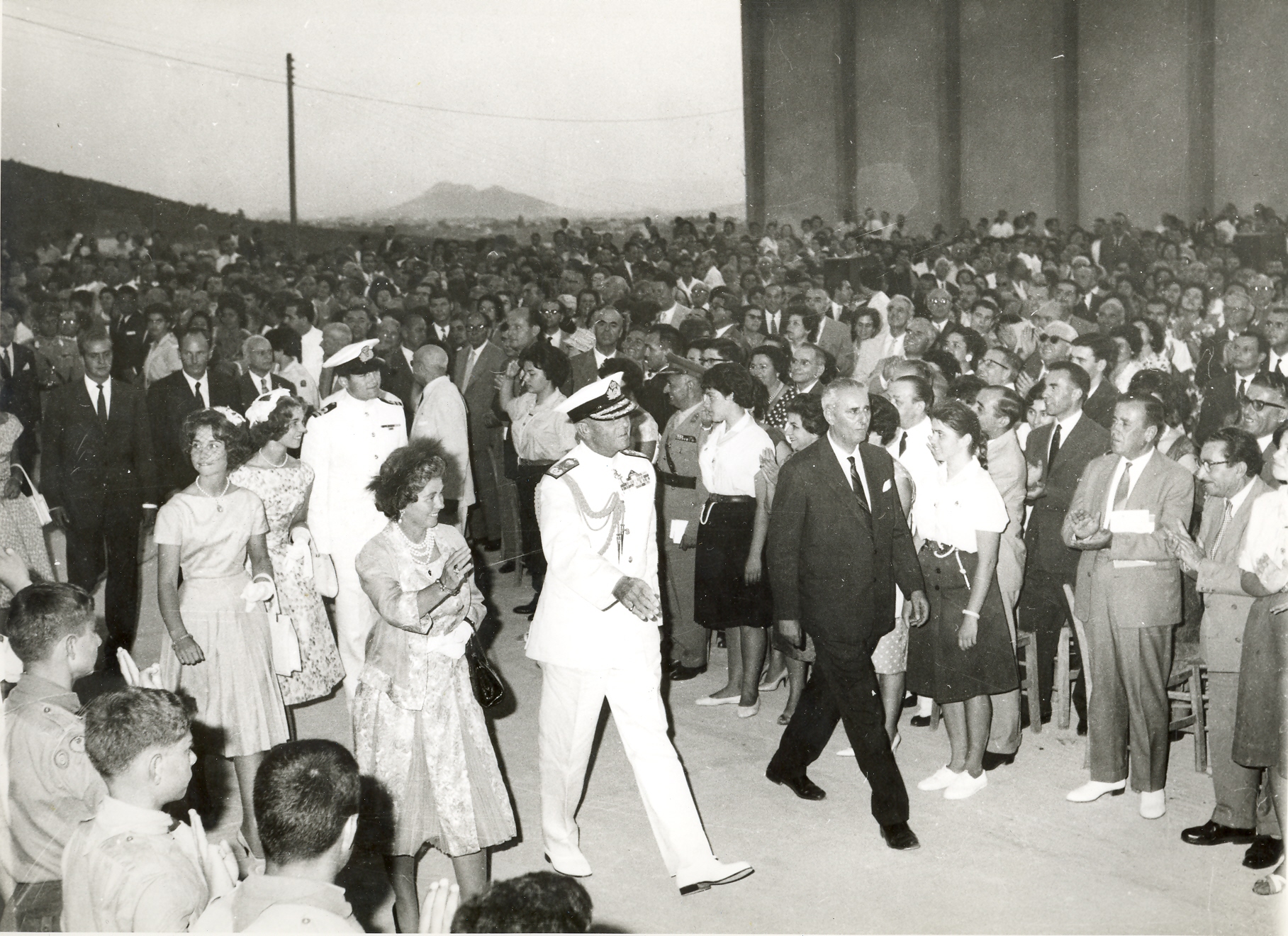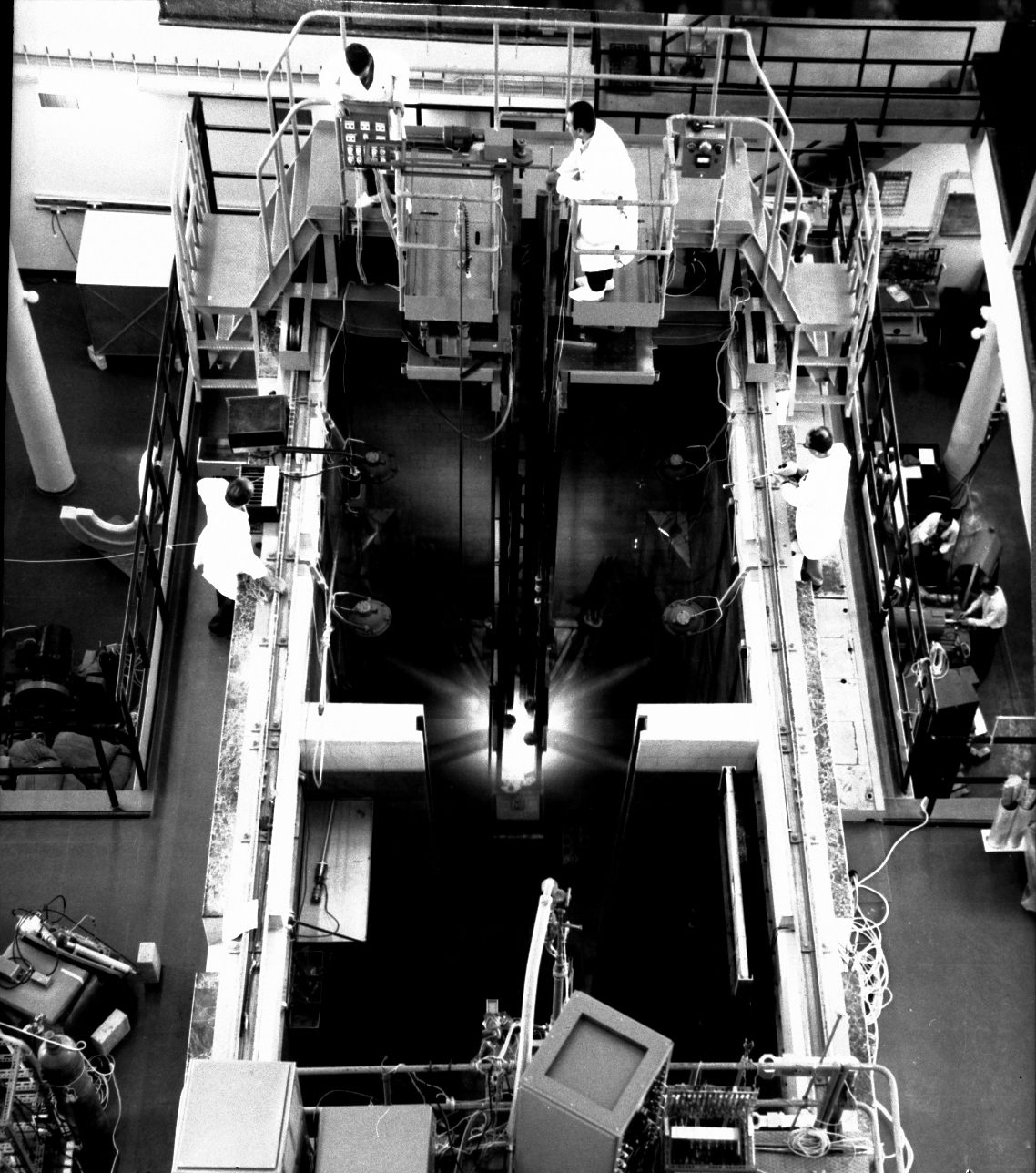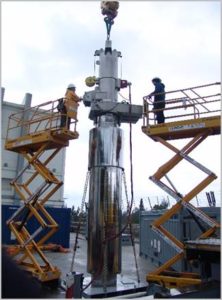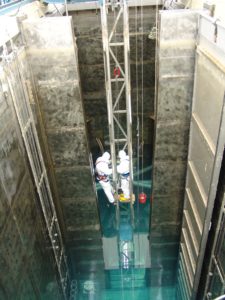Description
The Nuclear Research Reactor at the National Centre for Scientific Research “Demokritos” is a 5 MW open-pool type nuclear reactor using water as cooling medium and neutron moderator. The reactor was designed by AMF Atomics (USA) and achieved criticality for the first time in 1961. More information on the technical specifications of the reactor can be found here. Since 2004, the Research Reactor is in state of extended shut-down. The required license has been issued by the Greek Atomic Energy Commission.
History
The construction and operation of the Research Reactor is closely linked to the history of “Demokritos” center, since the then Nuclear Research Center “Demokritos” was established as a research center of the Greek Atomic Energy Commission for the peaceful applications of Nuclear Energy and having the task of construction and operation of the Greek Research Reactor. The contract for the construction of the research reactor was signed with AMF Atomics (USA) in January 1957, while at the same time scientific and technical personnel were sent to the USA for further training on reactor design and operation. This staff, after their return to Greece, was the nucleus of transfer of know-how for the construction of the building and systems of the research reactor at “Demokritos”.

Reactor inauguration July 31st 1961
The Research Reactor achieved criticality for the first time on July 31st, 1961. The inauguration of the reactor was attended by the political and scientific leadership of the country as well as by Ambassadors of other countries. This was followed by a period of operation at low power to make the necessary adjustments and measurements of physical parameters. The operation of the reactor at full power of 1 MW began in April 1964. The uses of the reactor concerned the service of research projects and the production of radioisotopes. It should be noted that the production of radioisotopes was of great importance to the country because all nuclear medicine diagnostic tests were performed with radioisotopes, such as the I-131 and Tc-99m, produced in the Demokritos reactor.
In 1970, the requirement for a higher neutron flux led to the decision to significantly upgrade the facility. The upgrade included the construction of a new cooling system consisting of primary and secondary circuits, heat exchangers, new cooling towers, replacement of the inner lining of the tank with stainless steel, as well as modifications to the reactor control and safety system. On July 27, 1971, after one year of intensive work, the reactor was operated at an increased power of 5 MW.
In June 1999, another significant conversion was made to the reactor introducing low-enrichment uranium fuel and the addition of beryllium reflector at the sides of the core. The conversion from high enrichment uranium fuel to low enrichment uranium was made in order to comply with new international nuclear security regulations, improve fuel consumption and achieve higher neutron flux in the experimental devices.

Activities at the reactor hall
Experimental devices for sample irradiations, neutron diffraction, neutron activation analysis and neutron dosimetry were operated in the reactor. In addition to the production of radioisotopes, the reactor has found important applications in experimental studies of reactor physics, in material studies, in archaeometry, in environmental studies, in biomedicine, in sterilization of tissue grafts, etc. The role of the reactor in the training of scientists in nuclear technology and radiation protection was also very important as it was the only nuclear installation in the country.
The research reactor operated until July 2004 when it was shut down for safety reasons in view of the Athens 2004 Olympic Games.
In 2006, a major project was launched to renovate and modernize the research reactor in accordance with modern research reactor safety guidelines and standards. The project included renovation of the reactor building and electromechanical systems, replacement of the primary cooling circuit and replacement of the control and safety system. At the same time, the installation of new neutron scattering instruments was under development. However, the reactor renovation program was discontinued in 2014 and the reactor is currently in a state of extended shutdown.
Maintenance of installation and equipment
During the current phase of extended shutdown of the research reactor, the technical staff of the laboratory is responsible for performing periodic inspections and maintenance of the mechanical, electrical and electronic devices of the installation. At the same time, the physical protection and radiation protection programs remain in force.
Return of the spent nuclear fuel to the country of origin

Loading of the spent fuel elements in their transport cask
The repatriation of the used nuclear fuel of the reactor to the USA was carried out on the basis of the contractual obligations of Greece at the initiative of the Department of Energy (DOE) of the USA to reduce the global threat through nuclear removal and in particular through the program of acceptance of used nuclear fuel by research reactors of foreign countries (The United States Department of Energy, US-DOE, Global Threat Reduction Initiative’s U.S. Nuclear Remove Program, Foreign Research Reactor Spent Nuclear Fuel Acceptance Program). The purpose of the program, introduced by the US-DOE in May 1996, was the repatriation of nuclear fuel and other nuclear material of US origin and had a final date of May 2019. After this date, no nuclear material was accepted by the US-DOE and each country must have its own solution to nuclear material management. Given that Greece does not have the appropriate infrastructure for the permanent storage or processing of nuclear material, it was decided to repatriate all irradiated fuel. The Greek Research Reactor used fuel was returned to the US-DOE facilities in the USA in early 2019.
Decommissioning plan

Technical works in the reactor pool during the reactor refurbishment and modernization program
Decommissioning is defined as all administrative and technical actions that should be taken at the end of a nuclear installation in order to allow the removal of the installation from the regulatory control and also assure the suitable physical and radiological protection to the workers, general public, and environment. The decommissioning plan is the technical document, in which is organized all information about the proposed decommissioning activities for the facility. It allows the regulatory body to make a proper evaluation and to ensure that decommissioning of the facility can be performed in a safe manner and in accordance to the standards of safety for the protection of health, life and property provided by IAEA.
The Research Reactor laboratory has undertaken the task to coordinate the preparation of the Decommissioning Plan of the Research Reactor in collaboration with the laboratories of Waste Management and Radioactive Materials and Health Physics, Radiobiology & Cytogenetics of INRASTES.
Participation in IAEA programs and activities
Members of the nuclear research reactor staff participate in programs and educational activities of the International Atomic Energy Agency related to physical protection, vulnerability assessment and security personnel training, in nuclear installations participating in the following Coordinated Research Programs: Nuclear Security for Research Reactors and Associated Facilities (J02006), Preventive and Protective Measures Against Insider Threats at Nuclear Facilities (JO2010) and Improving the Security of Radioactive Material & of Associated Facilities & Activities (J02011).
Education and Training
The staff of the research reactor laboratory organizes and participates in periodic training programs related to radiation protection and physical protection of nuclear facilities.





